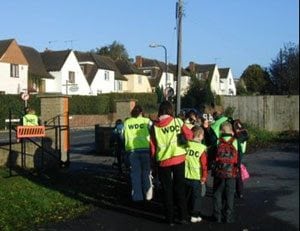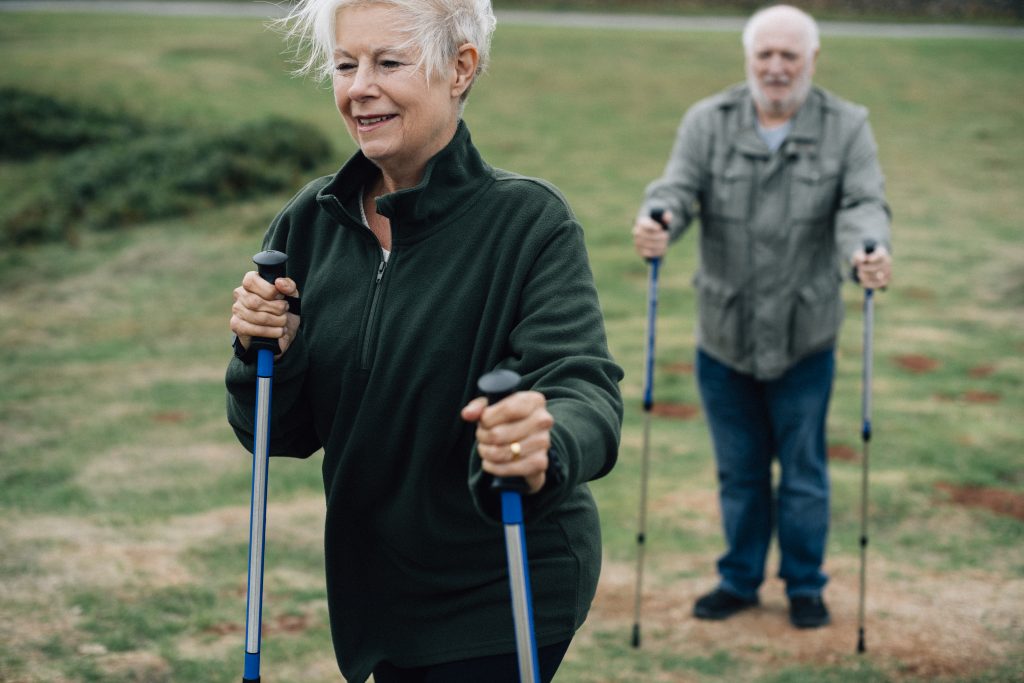SHAPE offers a variety of programs to help get all Albertans active:
Active Transportation: Park & Walk

A pre-determined parking lot acts as the meeting area for families who drive and then park and walk the remaining distance to school. Some communities require parents to walk with their children to school while others have designated adult volunteers to walk groups of children from the parking area to school.
Park and walk campaigns have the potential to reduce traffic congestion around a school and encourage physical activity for parents and children. This strategy is especially helpful for including families who live too far from the school to walk or who do not have a safe route to school.
Strategy: Park and walk
Definition
Instead of driving to the school, families drive to a remote parking lot and walk the remainder of the trip.
Advantages
- Includes families who live too far to walk or have an unsafe route.
- Encourages neighborhood involvement.
- Reduces traffic congestion at the school.
Considerations
- Requires identifying a safe route from the parking area to the school.
- Requires working with the parking lot's owner.
Quick steps to a park and walk activity
- Locate a parking lot within walking distance of the school. Work with lot owner to allow use.
- Map a safe route to school from parking area.
- Recruit volunteers if parents are not required to walk with their children.
- Promote it.
- Kick off.
- Track participation.
- Make changes to the activity as needed.
Putting It Into Practice: Park and Walk With a Walking School Bus
Arborfield, Newland and Barkham C.E. Junior School, Arborfield, England

In order to ease congestion around Arborfield, Newland and Barkham C.E. Junior School, the school's council instituted a School Travel Plan in March 2004. The plan includes a walking school bus that leaves from a designated parking area where parent volunteers supervise the children's walk to school.
After the plan was created, organizers asked parents to register their children and also to volunteer to lead the walking school buses. A local organization gave permission for the school to use its parking lot as the designated area for parents to meet the walking school bus. Children who participated were required to register each day, wear a fluorescent jacket and leave the lot at the predetermined time guided by volunteers.
As an incentive for children, school officials regularly ask special guests - like Santa Claus in December - to join their walks to school. School officials report many benefits of their activities: walking school buses are free of capital costs, and they help congestion and pollution. The children enjoy the walk, make new friends and have the opportunity to see things around them that they might miss if they were driven to school.
Source: Arborfield, Newland and Barkham C.E. Junior School; Wokingham District Council.
Walking Buddies
Walking Buddies is a program that encourages students in Alberta to use active transportation (walk or roll) to and from school or organized community groups with at least one other student or peer.
If you are a school, classroom, or community group interested in participating in Walking Buddies, and would like a Walking Buddies Kit mailed to you, please contact Lesley McEwan at 780-406-8530 or lesley@shapeab.com. Your Walking Buddies Kit will include master copies of the Walking Buddies forms, Star zipper pull awards, newsletter inserts, safety tips for parents and students and more!
If you would like an online version, you can download the NEW Walking & Wheelies Buddies toolkit here!
School Travel Planning
School Travel Planning Toolkit
Overview from Ontario Active Travel:
The STP process is guided and supported by an STP Facilitator who brings everyone together, coordinates activities, and uses this STP Toolkit to compile a School Travel Plan.
The Toolkit consists of two comprehensive Guides, plus their associated tools:
You can access the associated tools in three ways:
- The tools are available below, organized in order of recommended use throughout each of the six phases of STP. Click on an individual Phase box to see the tool contents and then click on the highlighted links.
- Each tool is named in bold and underlined throughout the two Guides. Click on those links.
- A summary of the tools is provided at the end of Section 2 in the Guide for Facilitators. Click on those links.
We launched this current and updated version of the STP Toolkit on 31 May 2018.
Watch our recorded webinar and view the slide deck.
For more information please click here to visit Ontario Active Travel.
Adults/Older Adults

SHAPE is developing Active Travel for Older Adults workshops and programs. Contact Lesley McEwan for further information.
